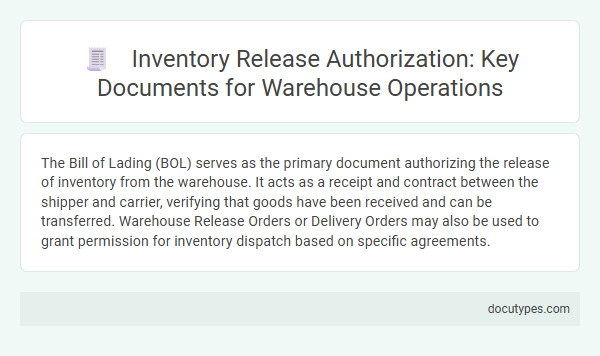The Bill of Lading (BOL) serves as the primary document authorizing the release of inventory from the warehouse. It acts as a receipt and contract between the shipper and carrier, verifying that goods have been received and can be transferred. Warehouse Release Orders or Delivery Orders may also be used to grant permission for inventory dispatch based on specific agreements.
Introduction to Inventory Release Authorization
What document authorizes the release of inventory from the warehouse? The inventory release authorization is a critical document that controls the movement of goods out of storage. It ensures accuracy, security, and accountability in warehouse operations.
Importance of Authorization in Warehouse Operations
The document that authorizes the release of inventory from the warehouse is the warehouse release order or goods dispatch note. This document ensures proper tracking, accountability, and control over inventory movement within supply chain operations. Authorization is crucial in warehouse operations to prevent theft, errors, and discrepancies, maintaining inventory accuracy and operational efficiency.
Types of Inventory Release Documents
The document that authorizes the release of inventory from the warehouse ensures proper tracking and accountability. It serves as official permission for the movement of goods out of inventory storage.
- Delivery Order - A document issued to validate and authorize the dispatch of specific inventory items to customers or other locations.
- Goods Release Note - An internal document recording details and approval for releasing inventory, often used for tracking and auditing purposes.
- Pick List - A document guiding warehouse staff on the quantity and location of items to be picked and released from inventory.
Standard Operating Procedures for Inventory Release
| Document Type | Description | Role in Authorization |
|---|---|---|
| Inventory Release Form (IRF) | A standardized document detailing item descriptions, quantities, and recipient information for inventory leaving the warehouse. | Serves as official authorization for warehouse personnel to release specific inventory items. |
| Warehouse Release Order (WRO) | Issued by inventory control or supply chain management to initiate the removal of stock from the warehouse. | Acts as a formal trigger to verify and release inventory based on approved requests. |
| Standard Operating Procedures (SOP) for Inventory Release | Detailed process documentation outlining steps, authorization levels, and approval workflows for inventory release. | Ensures consistent authorization compliance and record-keeping for all inventory movements. |
| Approval Signatures | Sign-offs from designated personnel such as warehouse managers, procurement officers, or supervisors. | Provides accountability and validates the legitimacy of the inventory release request. |
| Electronic Authorization Systems | Digital platforms that manage and track release requests, approvals, and inventory dispatch records. | Enhances accuracy and timeliness in authorizing inventory release under your management. |
Essential Information in Authorization Forms
The document that authorizes the release of inventory from the warehouse is commonly known as a Warehouse Release Authorization Form or Inventory Release Order. This essential document includes specific details such as item description, quantity, and authorized signatory to ensure accuracy and accountability.
Authorization forms must contain the date of request, purpose of release, and the signature of an authorized personnel to validate the transaction. Your timely completion of this form guarantees proper inventory tracking and prevents unauthorized withdrawals from the warehouse.
Roles and Responsibilities in Inventory Release
The document authorizing the release of inventory from the warehouse is typically a warehouse release order or an inventory withdrawal form. This document is issued by the inventory control manager or authorized personnel responsible for overseeing stock levels and ensuring accurate record-keeping. You must ensure that the approving authority verifies and signs off on the release to maintain accountability and prevent unauthorized inventory movement.
Electronic vs. Manual Authorization Processes
The document that authorizes the release of inventory from the warehouse is typically a Warehouse Release Order or an Inventory Release Authorization. This document verifies that inventory can be moved out of storage according to company policies and customer requirements.
Electronic authorization processes use software systems or ERP modules to generate and approve release orders instantly, increasing accuracy and reducing delays. Manual authorization involves physically signing release documents, which can slow down operations and increase the risk of errors. Your choice between electronic and manual processes impacts inventory control efficiency and traceability.
Security and Compliance in Inventory Release
The Warehouse Release Authorization Document is essential for legally permitting inventory to leave the storage facility. It ensures strict security measures and compliance protocols are followed during the inventory release process.
- Warehouse Release Authorization Document - This document is the primary authorization for releasing inventory from the warehouse, verifying approval from relevant personnel.
- Security Protocol Compliance - It enforces adherence to security standards that prevent unauthorized access or theft during inventory handling.
- Regulatory and Internal Compliance - The document maintains compliance with industry regulations and company policies, supporting accurate audit trails and operational accountability.
Common Challenges and Best Practices
The document authorizing the release of inventory from the warehouse is typically the Warehouse Release Order or Inventory Release Authorization. This document ensures proper control and accountability during the inventory dispatch process.
- Common Challenge: Incomplete Documentation - Missing or unclear release orders can delay shipments and cause inventory discrepancies.
- Common Challenge: Unauthorized Access - Without strict authorization controls, unauthorized personnel may release inventory, leading to security risks.
- Best Practice: Implement Digital Authorization Systems - Using electronic release orders improves accuracy, traceability, and reduces processing time.
You can enhance warehouse efficiency by standardizing the authorization process and regularly auditing release records.
What Document Authorizes the Release of Inventory from the Warehouse? Infographic

